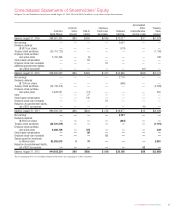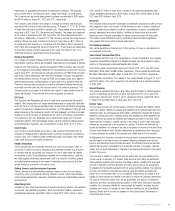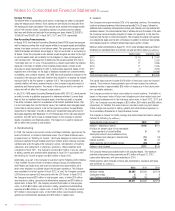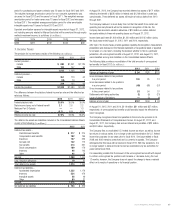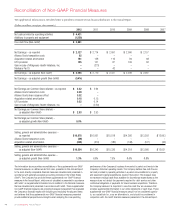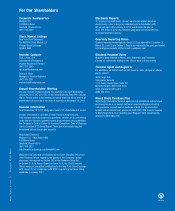Walgreens 2012 Annual Report Download - page 39
Download and view the complete annual report
Please find page 39 of the 2012 Walgreens annual report below. You can navigate through the pages in the report by either clicking on the pages listed below, or by using the keyword search tool below to find specific information within the annual report.
Consolidated Statement of Comprehensive Income. Fair value changes in derivatives
that are designated and qualify as cash flow hedges are recorded in other
comprehensive income, with any ineffectiveness recorded in interest expense.
In January 2010, the Company terminated its existing one-month future LIBOR
swaps that converted all $1.3 billion of its 4.875% fixed-rate debt to floating.
Upon termination, the Company received payment from its counterparty that
consisted of accrued interest and an amount representing the fair value of
the swaps. The related fair value benefit attributed to the Company’s debt
continues to amortize over the life of the debt, which matures on August 1, 2013.
The Company then entered into six-month LIBOR in arrears swaps with two
counterparties for all of its $1.3 billion 4.875% fixed-rate debt.
In May 2011, the Company entered into interest rate swaps with two counterparties
converting $250 million of its 5.250% fixed-rate notes to a floating interest rate
based on the six-month LIBOR in arrears plus a constant spread. In March 2012,
the Company entered into interest rate swaps with the same two counterparties
converting an additional $250 million of its 5.250% fixed-rate notes to a floating
interest rate based on the one-month LIBOR in arrears plus a constant spread.
All swap termination dates coincide with the notes maturity date, January 15, 2019.
In the fourth quarter of fiscal 2012, the Company entered into three forward starting
interest rate swap transactions locking in the then current interest rate on
$1.0 billion of its anticipated debt issuance in connection with the Alliance Boots
investment. The swaps were terminated subsequent to year end when the hedged
debt was issued in September 2012. The swap transactions were designated as
cash flow hedges.
The notional amounts of derivative instruments outstanding at August 31, 2012
and 2011, were as follows (In millions) :
2012 2011
Derivatives designated as hedges:
Interest rate swaps $ 1,800 $ 1,550
Forward interest rate swaps 1,000 —
The changes in fair value of the notes attributable to the hedged risk are included
in long-term debt on the Consolidated Balance Sheets (see Note 8) and amortized
through maturity. At August 31, 2012 and 2011, the Company had net unamortized
fair value changes of $40 million and $57 million, respectively. Changes in fair value
of the cash flow hedges are included in other comprehensive income, with any
ineffectiveness recorded directly to interest expense. Upon termination of the cash
flow hedges, cumulative changes included in other comprehensive income will be
amortized with the anticipated debt’s cash flow. No material fair value changes or
ineffectiveness was recorded through other comprehensive income in fiscal 2012.
The fair value and balance sheet presentation of derivative instruments at
August 31, 2012, were as follows (In millions) :
Location in
Consolidated Balance Sheet 2012 2011
Asset derivatives designated as hedges:
Interest rate swaps Other current assets $ 24 $ —
Forward interest rate swaps Other non-current assets — —
Interest rate swaps Other non-current assets 39 63
Gains and losses relating to the ineffectiveness of the Company’s derivative instru-
ments are recorded in interest expense on the Consolidated Condensed Statement
of Comprehensive Income. The Company recorded a $2 million gain in fiscal 2012
and $1 million in fiscal 2011.
10. Fair Value Measurements
The Company measures certain assets and liabilities in accordance with ASC Topic
820, Fair Value Measurements and Disclosures. ASC Topic 820 defines fair value
as the price that would be received for an asset or paid to transfer a liability in
an orderly transaction between market participants on the measurement date.
In addition, it establishes a fair value hierarchy that prioritizes observable and
unobservable inputs used to measure fair value into three broad levels:
Level 1 – Quoted prices in active markets that are accessible at the measurement
date for identical assets and liabilities. The fair value hierarchy gives the
highest priority to Level 1 inputs.
Level 2 – Observable inputs other than quoted prices in active markets.
Level 3 – Unobservable inputs for which there is little or no market data available.
The fair value hierarchy gives the lowest priority to Level 3 inputs.
Assets and liabilities measured at fair value on a recurring basis were
as follows (In millions):
August 31, 2012 Level 1 Level 2 Level 3
Assets:
Money market funds $ 820 $ 820 $ — $ —
Interest rate swaps 63 — 63 —
Forward interest rate swaps — — — —
August 31, 2011 Level 1 Level 2 Level 3
Assets:
Money market funds $ 1,239 $ 1,239 $ — $ —
Interest rate swaps 63 — 63 —
Interest rate swaps are valued using the six-month and one-month LIBOR in arrears
rates. See Note 9 for additional disclosure regarding financial instruments.
Assets measured at fair value on a nonrecurring basis were as follows (In millions):
August 31, 2012 Level 1 Level 2 Level 3
Assets:
Alliance Boots call option $ 866 — — $ 866
The call option was valued using a Monte Carlo simulation using assumptions
surrounding Walgreens equity value as well as the potential impacts of the certain
provisions of the Purchase and Option Agreement dated June 18, 2012, by and
among the Company, Alliance Boots and AB Acquisitions Holdings Limited.
The Company reports its debt instruments under the guidance of ASC Topic 825,
Financial Instruments, which requires disclosure of the fair value of the Company’s
debt in the footnotes to the consolidated condensed financial statements.
See Note 8 for further details.
11. Commitments and Contingencies
The Company is involved in legal proceedings, including the matters described below,
and is subject to investigations, inspections, audits, inquiries and similar actions by
governmental authorities, arising in the normal course of the Company’s business.
Litigation, in general, and securities and class action litigation, in particular, can be
expensive and disruptive. Some of these suits may purport or may be determined to
be class actions and/or involve parties seeking large and/or indeterminate amounts,
including punitive or exemplary damages, and may remain unresolved for several
years. From time to time, the Company is also involved in legal proceedings as a
plaintiff involving antitrust, tax, contract, intellectual property and other matters.
Gain contingencies, if any, are recognized when they are realized. The results of
legal proceedings are often uncertain and difficult to predict, and the costs incurred
in litigation can be substantial, regardless of the outcome.
On a quarterly basis, the Company assesses its liabilities and contingencies for
outstanding legal proceedings and reserves are established on a case-by-case basis
for those legal claims for which management concludes that it is probable that a
loss will be incurred and that the amount of such loss can be reasonably estimated.
Management’s assessment of current litigation and other legal proceedings, including
the corresponding accruals, could change because of the discovery of facts with
respect to legal actions or other proceedings pending against the Company which
are not presently known. Adverse determinations by judges, juries or other parties
2012 Walgreens Annual Report 37


